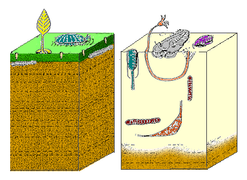Predation

Predation is a
Predators may actively search for or pursue prey or wait for it, often concealed. When prey is detected, the predator assesses whether to attack it. This may involve
Predators are adapted and often highly specialized for hunting, with acute senses such as
Predation has a powerful
Definition
At the most basic level, predators kill and eat other organisms. However, the concept of predation is broad, defined differently in different contexts, and includes a wide variety of feeding methods; and some relationships that result in the prey's death are not generally called predation. A

There are other difficult and borderline cases.
Taxonomic range
While examples of predators among mammals and birds are well known,
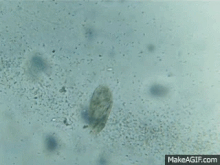
Seed predation is restricted to mammals, birds, and insects but is found in almost all terrestrial ecosystems.
Some plants, like the
Many species of
Foraging

To feed, a predator must search for, pursue and kill its prey. These actions form a foraging cycle.[26][27] The predator must decide where to look for prey based on its geographical distribution; and once it has located prey, it must assess whether to pursue it or to wait for a better choice. If it chooses pursuit, its physical capabilities determine the mode of pursuit (e.g., ambush or chase).[28][29] Having captured the prey, it may also need to expend energy handling it (e.g., killing it, removing any shell or spines, and ingesting it).[25][26]
Search
Predators have a choice of search modes ranging from sit-and-wait to active or widely foraging.

Prey distributions are often clumped, and predators respond by looking for patches where prey is dense and then searching within patches.[25] Where food is found in patches, such as rare shoals of fish in a nearly empty ocean, the search stage requires the predator to travel for a substantial time, and to expend a significant amount of energy, to locate each food patch.[33] For example, the black-browed albatross regularly makes foraging flights to a range of around 700 kilometres (430 miles), up to a maximum foraging range of 3,000 kilometres (1,860 miles) for breeding birds gathering food for their young.[a][34] With static prey, some predators can learn suitable patch locations and return to them at intervals to feed.[33] The optimal foraging strategy for search has been modelled using the marginal value theorem.[35]
Search patterns often appear random. One such is the Lévy walk, that tends to involve clusters of short steps with occasional long steps. It is a good fit to the behaviour of a wide variety of organisms including bacteria, honeybees, sharks and human hunter-gatherers.[36][37]
Assessment
Having found prey, a predator must decide whether to pursue it or keep searching. The decision depends on the costs and benefits involved. A bird foraging for insects spends a lot of time searching but capturing and eating them is quick and easy, so the efficient strategy for the bird is to eat every palatable insect it finds. By contrast, a predator such as a lion or falcon finds its prey easily but capturing it requires a lot of effort. In that case, the predator is more selective.[28]
One of the factors to consider is size. Prey that is too small may not be worth the trouble for the amount of energy it provides. Too large, and it may be too difficult to capture. For example, a mantid captures prey with its forelegs and they are optimized for grabbing prey of a certain size. Mantids are reluctant to attack prey that is far from that size. There is a positive correlation between the size of a predator and its prey.[28]
A predator may also assess a patch and decide whether to spend time searching for prey in it.
Capture
To capture prey, predators have a spectrum of pursuit modes that range from overt chase (pursuit predation) to a sudden strike on nearby prey (ambush predation).[25][39][12] Another strategy in between ambush and pursuit is ballistic interception, where a predator observes and predicts a prey's motion and then launches its attack accordingly.[40]
Ambush
Ambush or sit-and-wait predators are carnivorous animals that capture prey by stealth or surprise. In animals, ambush predation is characterized by the predator's scanning the environment from a concealed position until a prey is spotted, and then rapidly executing a fixed surprise attack.
Ballistic interception

Ballistic interception is the strategy where a predator observes the movement of a prey, predicts its motion, works out an interception path, and then attacks the prey on that path. This differs from ambush predation in that the predator adjusts its attack according to how the prey is moving.[40] Ballistic interception involves a brief period for planning, giving the prey an opportunity to escape. Some frogs wait until snakes have begun their strike before jumping, reducing the time available to the snake to recalibrate its attack, and maximising the angular adjustment that the snake would need to make to intercept the frog in real time.[40] Ballistic predators include insects such as dragonflies, and vertebrates such as archerfish (attacking with a jet of water), chameleons (attacking with their tongues), and some colubrid snakes.[40]
Pursuit
In pursuit predation, predators chase fleeing prey. If the prey flees in a straight line, capture depends only on the predator's being faster than the prey.
An extreme form of pursuit is endurance or persistence hunting, in which the predator tires out the prey by following it over a long distance, sometimes for hours at a time. The method is used by human hunter-gatherers and by canids such as African wild dogs and domestic hounds. The African wild dog is an extreme persistence predator, tiring out individual prey by following them for many miles at relatively low speed.[50]
A specialised form of pursuit predation is the
Pursuit predators may be
Handling
Once the predator has captured the prey, it has to handle it: very carefully if the prey is dangerous to eat, such as if it possesses sharp or poisonous spines, as in many prey fish. Some catfish such as the Ictaluridae have spines on the back (dorsal) and belly (pectoral) which lock in the erect position; as the catfish thrashes about when captured, these could pierce the predator's mouth, possibly fatally. Some fish-eating birds like the osprey avoid the danger of spines by tearing up their prey before eating it.[53]
Solitary versus social predation
In social predation, a group of predators cooperates to kill prey. This makes it possible to kill creatures larger than those they could overpower singly; for example,
Predators of different species sometimes cooperate to catch prey. In
Social hunting allows predators to tackle a wider range of prey, but at the risk of competition for the captured food. Solitary predators have more chance of eating what they catch, at the price of increased expenditure of energy to catch it, and increased risk that the prey will escape.
Specialization
Physical adaptations
Under the pressure of natural selection, predators have evolved a variety of physical adaptations for detecting, catching, killing, and digesting prey. These include speed, agility, stealth, sharp senses, claws, teeth, filters, and suitable digestive systems.[72]
For
Predators including
Many predators are powerfully built and can catch and kill animals larger than themselves; this applies as much to small predators such as ants and shrews as to big and visibly muscular carnivores like the cougar and lion.[73][2][75]
-
Skull of brown bear has large pointed canines for killing prey, and self-sharpening carnassial teeth at rear for cutting flesh with a scissor-like action
-
Largejack jumper ant
-
Crab spider, an ambush predator with forward-facing eyes, catching another predator, a field digger wasp
-
Red-tailed hawk uses sharp hooked claws and beak to kill and tear up its prey
-
Specialist: a great blue heron with a speared fish
-
Indian python unhinges its jaw to swallow large prey like this chital
Diet and behaviour
Predators are often highly specialized in their diet and hunting behaviour; for example, the Eurasian lynx only hunts small ungulates.[76] Others such as leopards are more opportunistic generalists, preying on at least 100 species.[77][78] The specialists may be highly adapted to capturing their preferred prey, whereas generalists may be better able to switch to other prey when a preferred target is scarce. When prey have a clumped (uneven) distribution, the optimal strategy for the predator is predicted to be more specialized as the prey are more conspicuous and can be found more quickly;[79] this appears to be correct for predators of immobile prey, but is doubtful with mobile prey.[80]
In size-selective predation, predators select prey of a certain size.[81] Large prey may prove troublesome for a predator, while small prey might prove hard to find and in any case provide less of a reward. This has led to a correlation between the size of predators and their prey. Size may also act as a refuge for large prey. For example, adult elephants are relatively safe from predation by lions, but juveniles are vulnerable.[82]
Camouflage and mimicry
Members of the
In
Venom
Many smaller predators such as the
Electric fields
Several groups of predatory fish have the ability to detect, track, and sometimes, as in the electric ray, to incapacitate their prey by sensing and generating electric fields.[91][92][93] The electric organ is derived from modified nerve or muscle tissue.[94]
Physiology
Physiological adaptations to predation include the ability of predatory bacteria to digest the complex peptidoglycan polymer from the cell walls of the bacteria that they prey upon.[23] Carnivorous vertebrates of all five major classes (fishes, amphibians, reptiles, birds, and mammals) have lower relative rates of sugar to amino acid transport than either herbivores or omnivores, presumably because they acquire plenty of amino acids from the animal proteins in their diet.[95]
Antipredator adaptations
To counter predation, prey have evolved defences for use at each stage of an attack.[96][12] They can try to avoid detection,[97] such as by using camouflage and mimicry.[98] They can detect predators[99] and warn others of their presence.[100][101] If detected, they can try to avoid being the target of an attack, for example, by
Coevolution

Predators and prey are natural enemies, and many of their adaptations seem designed to counter each other. For example, bats have sophisticated

The metaphor of an arms race implies ever-escalating advances in attack and defence. However, these adaptations come with a cost; for instance, longer legs have an increased risk of breaking,[121] while the specialized tongue of the chameleon, with its ability to act like a projectile, is useless for lapping water, so the chameleon must drink dew off vegetation.[122]
The "life-dinner" principle has been criticized on multiple grounds. The extent of the asymmetry in natural selection depends in part on the heritability of the adaptive traits.[122] Also, if a predator loses enough dinners, it too will lose its life.[121][122] On the other hand, the fitness cost of a given lost dinner is unpredictable, as the predator may quickly find better prey. In addition, most predators are generalists, which reduces the impact of a given prey adaption on a predator. Since specialization is caused by predator-prey coevolution, the rarity of specialists may imply that predator-prey arms races are rare.[122]
It is difficult to determine whether given adaptations are truly the result of coevolution, where a prey adaptation gives rise to a predator adaptation that is countered by further adaptation in the prey. An alternative explanation is escalation, where predators are adapting to competitors, their own predators or dangerous prey.[123] Apparent adaptations to predation may also have arisen for other reasons and then been co-opted for attack or defence. In some of the insects preyed on by bats, hearing evolved before bats appeared and was used to hear signals used for territorial defence and mating.[124] Their hearing evolved in response to bat predation, but the only clear example of reciprocal adaptation in bats is stealth echolocation.[125]
A more symmetric arms race may occur when the prey are dangerous, having spines, quills, toxins or venom that can harm the predator. The predator can respond with avoidance, which in turn drives the evolution of mimicry. Avoidance is not necessarily an evolutionary response as it is generally learned from bad experiences with prey. However, when the prey is capable of killing the predator (as can a coral snake with its venom), there is no opportunity for learning and avoidance must be inherited. Predators can also respond to dangerous prey with counter-adaptations. In western North America, the common garter snake has developed a resistance to the toxin in the skin of the rough-skinned newt.[122]
Role in ecosystems
Predators affect their ecosystems not only directly by eating their own prey, but by indirect means such as reducing predation by other species, or altering the foraging behaviour of a herbivore, as with the biodiversity effect of wolves on riverside vegetation or sea otters on kelp forests. This may explain population dynamics effects such as the cycles observed in lynx and snowshoe hares.[126][127][128]
Trophic level
One way of classifying predators is by trophic level. Carnivores that feed on herbivores are secondary consumers; their predators are tertiary consumers, and so forth.[129] At the top of this food chain are apex predators such as lions.[130] Many predators however eat from multiple levels of the food chain; a carnivore may eat both secondary and tertiary consumers.[131] This means that many predators must contend with intraguild predation, where other predators kill and eat them. For example, coyotes compete with and sometimes kill gray foxes and bobcats.[132]
Trophic transfer
Trophic transfer within an ecosystem refers to the transport of energy and nutrients as a result of predation. Energy passes from one trophic level to the next as predators consume organic matter from another organism's body. Within each transfer, while there are uses of energy, there are also losses of energy.
Marine trophic levels vary depending on locality and the size of the primary producers. There are generally up to six trophic levels in the open ocean, four over continental shelves, and around three in upwelling zones.[133] For example, a marine habitat with five trophic levels could be represented as follows: Herbivores (feed primarily on phytoplankton); Carnivores (feed primarily on other zooplankton/animals); Detritivores (feed primarily on dead organic matter/detritus; Omnivores (feed on a mixed diet of phyto- and zooplankton and detritus); and Mixotrophs which combine autotrophy (using light energy to grow without intake of any additional organic compounds or nutrients) with heterotrophy (feeding on other plants and animals for energy and nutrients—herbivores, omnivores and carnivores, and detritivores).
Trophic transfer efficiency measures how effectively energy is transferred or passed up through higher trophic levels of the marine food web. As energy moves up the trophic levels, it decreases due to heat, waste, and the natural metabolic processes that occur as predators consume their prey. The result is that only about 10% of the energy at any trophic level is transferred to the next level. This is often referred to as "the 10% rule" which limits the number of trophic levels that an individual ecosystem is capable of supporting.[134]
Biodiversity maintained by apex predation
Predators may increase the biodiversity of communities by preventing a single species from becoming dominant. Such predators are known as keystone species and may have a profound influence on the balance of organisms in a particular ecosystem.[135] Introduction or removal of this predator, or changes in its population density, can have drastic cascading effects on the equilibrium of many other populations in the ecosystem. For example, grazers of a grassland may prevent a single dominant species from taking over.[136]

The elimination of wolves from
Population dynamics
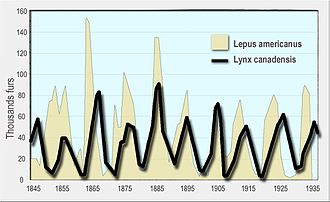
In the absence of predators, the population of a species can grow exponentially until it approaches the carrying capacity of the environment.[138] Predators limit the growth of prey both by consuming them and by changing their behavior.[139] Increases or decreases in the prey population can also lead to increases or decreases in the number of predators, for example, through an increase in the number of young they bear.
Cyclical fluctuations have been seen in populations of predator and prey, often with offsets between the predator and prey cycles. A well-known example is that of the
A simple model of a system with one species each of predator and prey, the Lotka–Volterra equations, predicts population cycles.[143] However, attempts to reproduce the predictions of this model in the laboratory have often failed; for example, when the protozoan Didinium nasutum is added to a culture containing its prey, Paramecium caudatum, the latter is often driven to extinction.[144]
The Lotka–Volterra equations rely on several simplifying assumptions, and they are structurally unstable, meaning that any change in the equations can stabilize or destabilize the dynamics.[145][146] For example, one assumption is that predators have a linear functional response to prey: the rate of kills increases in proportion to the rate of encounters. If this rate is limited by time spent handling each catch, then prey populations can reach densities above which predators cannot control them.[144] Another assumption is that all prey individuals are identical. In reality, predators tend to select young, weak, and ill individuals, leaving prey populations able to regrow.[147]
Many factors can stabilize predator and prey populations.[148] One example is the presence of multiple predators, particularly generalists that are attracted to a given prey species if it is abundant and look elsewhere if it is not.[149] As a result, population cycles tend to be found in northern temperate and subarctic ecosystems because the food webs are simpler.[150] The snowshoe hare-lynx system is subarctic, but even this involves other predators, including coyotes, goshawks and great horned owls, and the cycle is reinforced by variations in the food available to the hares.[151]
A range of mathematical models have been developed by relaxing the assumptions made in the Lotka–Volterra model; these variously allow animals to have
Evolutionary history
Predation dates from before the rise of commonly recognized carnivores by hundreds of millions (perhaps billions) of years. Predation has evolved repeatedly in different groups of organisms.
The earliest predators were microbial organisms, which engulfed or grazed on others. Because the fossil record is poor, these first predators could date back anywhere between 1 and over 2.7 Gya (billion years ago).[5] Predation visibly became important shortly before the Cambrian period—around 550 million years ago—as evidenced by the almost simultaneous development of calcification in animals and algae,[161] and predation-avoiding burrowing. However, predators had been grazing on micro-organisms since at least 1,000 million years ago,[5][162][163] with evidence of selective (rather than random) predation from a similar time.[164]
The
-
nematocysts.[165]
-
Thesea floor change from minimal burrowing (left) to a diverse burrowing fauna (right), probably to avoid new Cambrianpredators.
-
Dunkleosteus, a Devonian placoderm, perhaps the world's first vertebrate superpredator, reconstruction
-
, could fly to escape terrestrial predators. Its large size, with a wingspan of 65 cm (30 in), may reflect the lack of vertebrate aerial predators at that time.
-
theropod dinosaur of the Cretaceous, reconstruction
In human society

Practical uses
Humans, as
In biological pest control, predators (and parasitoids) from a pest's natural range are introduced to control populations, at the risk of causing unforeseen problems. Natural predators, provided they do no harm to non-pest species, are an environmentally friendly and sustainable way of reducing damage to crops and an alternative to the use of chemical agents such as pesticides.[180]
Symbolic uses
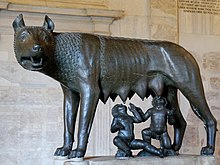
In film, the idea of the predator as a dangerous if humanoid enemy is used in the 1987 science fiction horror action film Predator and its three sequels.[181][182] A terrifying predator, a gigantic man-eating great white shark, is central, too, to Steven Spielberg's 1974 thriller Jaws.[183]
Among poetry on the theme of predation, a predator's consciousness might be explored, such as in Ted Hughes's Pike.[184] The phrase "Nature, red in tooth and claw" from Alfred, Lord Tennyson's 1849 poem "In Memoriam A.H.H." has been interpreted as referring to the struggle between predators and prey.[185]
In mythology and folk fable, predators such as the fox and wolf have mixed reputations.
See also
- Ecology of fear
- Predation problem
- Predator–prey reversal
- Wa-Tor
- Cannibalism
Notes
- ^ A range of 3000 kilometres means a flight distance of at least 6000 kilometres out and back.
References
- ISBN 978-1-118-23185-2.
- ^ .
- PMID 24229807.
- )
- ^ a b c d e f g Bengtson, S. (2002). "Origins and early evolution of predation". In Kowalewski, M.; Kelley, P. H. (eds.). The fossil record of predation. The Paleontological Society Papers 8 (PDF). The Paleontological Society. pp. 289–317.
- ^ .
- S2CID 2145031.
- ^ )
- S2CID 56280901.
- ISBN 978-0226455082.
- )
- ^ a b c d e f Stevens, Alison N. P. (2010). "Predation, Herbivory, and Parasitism". Nature Education Knowledge. 3 (10): 36.
- ^ "Predators, parasites and parasitoids". Australian Museum. Retrieved 19 September 2018.
- ISBN 9780520251182.
- ISBN 9781429223188.
- PMID 28861006.
- .
- PMID 26915464.
- .
- S2CID 231595236.
- PMID 14169325.
- ^ S2CID 5432036.
- ^ ISBN 978-3-540-38577-6.
- . summarizes findings from many authors.
- ^ ISBN 9780198030133. Archived from the original(PDF) on 12 July 2018. Retrieved 20 September 2018.
- ^ S2CID 85094710.
- ISBN 978-1-4419-3186-3.
- ^ a b c d Pianka, Eric R. (2011). Evolutionary ecology (7th (eBook) ed.). Eric R. Pianka. pp. 78–83.
- ISBN 9780691023823.
- ^ a b c d Bell 2012, pp. 4–5
- ISBN 9780199797066.
- S2CID 4334462.
- ^ a b Bell 2012, pp. 69–188
- .
- PMID 1273796.
- PMID 25835600.
- PMID 18528368.
- S2CID 53172079.
- S2CID 13809116.
- ^ PMID 26117833.
- ^ PMID 23175528.
- ^ "Cougar". Hinterland Who's Who. Canadian Wildlife Service and Canadian Wildlife Federation. Archived from the original on 18 May 2007. Retrieved 22 May 2007.
- ^ "Pikes (Esocidae)" (PDF). Indiana Division of Fish and Wildlife. Retrieved 3 September 2018.
- ^ Bray, Dianne. "Eastern Frogfish, Batrachomoeus dubius". Fishes of Australia. Archived from the original on 14 September 2014. Retrieved 14 September 2014.
- ^ "Trapdoor spiders". BBC. Retrieved 12 December 2014.
- ^ "Trapdoor spider". Arizona-Sonora Desert Museum. 2014. Retrieved 12 December 2014.
- PMID 15695203.
- ISBN 978-1-4398-9759-1.
- PMID 23784698.
- PMID 27023457.
Cursorial hunting strategies range from one extreme of transient acceleration, power and speed to the other extreme of persistence and endurance with prey being fatigued to facilitate capture.Dogs and humans are considered to rely on endurance rather than outright speed and manoeuvrability for success when hunting cursorially.
- S2CID 17923052.
- PMID 26393325.
- JSTOR 3565418.
- ^ S2CID 4214982.
- PMID 25389760.
- S2CID 86371484.
- ^ Beauchamp 2012, pp. 7–12
- ^ Dawson, James W. (1988). The cooperative breeding system of the Harris' Hawk in Arizona (Masters thesis). The University of Arizona. Retrieved 17 November 2017.
- PMID 23612306.
- ^ Yong, Ed (24 April 2013). "Groupers Use Gestures to Recruit Morays For Hunting Team-Ups". National Geographic. Archived from the original on 17 September 2018. Retrieved 17 September 2018.
- ^ Toft, Klaus (Producer) (2007). Killers in Eden (DVD documentary). Australian Broadcasting Corporation. Archived from the original on 12 August 2009. ISBN R-105732-9.
- ^ PMID 28828280.
- PMID 30087391.
- ^ "Ambush Predators". Sibley Nature Center. Archived from the original on 2 August 2021. Retrieved 17 September 2018.
- PMID 29491995.
- ^ Quenqua, Douglas (11 October 2017). "Solitary Pumas Turn Out to Be Mountain Lions Who Lunch". The New York Times. Retrieved 17 September 2018.
- ISBN 978-0465052998.
- PMID 22363687.
- ^ "How do Spiders Hunt?". American Museum of Natural History. 25 August 2014. Retrieved 5 September 2018.
- ISBN 9780123741448.
- ^ "Zooplankton". MarineBio Conservation Society. 17 June 2018. Retrieved 5 September 2018.
- ^ Bar-Yam. "Predator-Prey Relationships". New England Complex Systems Institute. Retrieved 7 September 2018.
- ^ a b c "Predator & Prey: Adaptations" (PDF). Royal Saskatchewan Museum. 2012. Archived from the original (PDF) on 3 April 2018. Retrieved 19 April 2018.
- ISBN 978-0-691-00080-0.
- PMID 21199247.
- ISBN 978-985-463-456-2.
- ISBN 978-3-319-22246-2.
- doi:10.1111/j.1469-7998.2006.00139.x. Archived from the original(PDF) on 29 February 2020. Retrieved 20 April 2018.
- S2CID 8420787.
- S2CID 44045919.
- JSTOR 1934223.
- PMID 18177336.
- ^ Cott 1940, pp. 12–13
- S2CID 39386614.
- ISBN 978-0-300-17896-8.
- ^ Bester, Cathleen (5 May 2017). "Antennarius striatus". Florida Museum. University of Florida. Retrieved 31 January 2018.
- ISBN 978-81-315-0104-7.)
{{cite book}}: CS1 maint: multiple names: authors list (link - ISBN 978-0-8151-4387-1.
- ISBN 978-0-470-33557-4.
- S2CID 17572816.
- PMID 19376956.
- PMID 19033131.
- PMID 26485580.
- ^ Kramer, Bernd (1996). "Electroreception and communication in fishes" (PDF). Progress in Zoology. 42.
- JSTOR 1310825.
- ^ Ruxton, Sherratt & Speed 2004, pp. vii–xii
- ^ Caro 2005, pp. 67–114
- PMID 28533458.
- ^ Caro 2005, pp. 13–15
- S2CID 2295026.
- S2CID 53164940.
- ^ Cott 1940, pp. 241–307
- S2CID 12031679.
- PMID 7816816.
- ^ Ruxton, Sherratt & Speed 2004, pp. 70–81
- ^ Caro 2005, pp. 663–684
- ^ Beauchamp 2012, pp. 83–88
- ISBN 9780198508182.
- ^ Ruxton, Sherratt & Speed 2004, pp. 54–55
- JSTOR 1445113.
- S2CID 9744565.
- ^ Cott 1940, pp. 368–389
- .
- ^ Edmunds, Malcolm (2012). "Deimatic Behavior". Springer. Retrieved 31 December 2012.
- ^ Caro 2005, pp. v–xi, 4–5
- ^ Caro 2005, p. 413–414
- ^ Jacobs & Bastian 2017, p. 4
- ISBN 9780199874545.
- S2CID 22739360.
- ^ S2CID 9695900.
- ^ S2CID 27317468.
- ^ JSTOR 1313476.
- .
- ^ Jacobs & Bastian 2017, p. 8
- ^ Jacobs & Bastian 2017, p. 107
- PMID 32215909.
- ISSN 0012-9658.
- ^ PMID 18831163.
- JSTOR 1930126.
- hdl:11250/2492589.
- S2CID 4161183.
- S2CID 24289407.
- ^ Lalli, C. M.; Parsons, T. R. (1997). Biological Oceanography: An Introduction (2nd ed.). The Open University. p. 116.
- ^ "Energy transfer in ecosystems". National Geographic. 18 February 2023. Retrieved 18 February 2023.
- ISBN 978-3642580017.
- ISBN 978-0-471-38914-9.
- ^ .
- ISBN 9780521532235.
- JSTOR 3450359.
- hdl:1807/359.
- ^ Krebs, Charley; Myers, Judy (12 July 2014). "The Snowshoe Hare 10-year Cycle – A Cautionary Tale". Ecological rants. University of British Columbia. Retrieved 2 October 2018.
- ^ "Predators and their prey". BBC Bitesize. BBC. Retrieved 7 October 2015.
- ISBN 978-0122874505.
- ^ ISBN 9781400833023.
- ISBN 9781400847259.
- ISBN 9780191588518.
- PMID 20333305.
- ^ Rockwood 2009, p. 281
- ^ Rockwood 2009, p. 246
- ^ Rockwood 2009, pp. 271–272
- ^ Rockwood 2009, p. 272–273
- ^ .
- ISBN 978-0-691-09291-1.
- S2CID 121559550.
- .
- PMID 3961711.
- .
- PMID 19751753.
- .
- ^ ISBN 978-0-521-82149-0.
- S2CID 26792772.
- S2CID 2302113.
- S2CID 83713101.
- S2CID 92505644.
- ^ PMID 35879540.
- OCLC 840283264.
- PMID 24112975.
- S2CID 86203770.
- ^ Carr, Robert K. (2010). "Paleoecology of Dunkleosteus terrelli (Placodermi: Arthrodira)". Kirtlandia. 57.
- S2CID 131583311. Archived from the originalon 24 August 2013. Retrieved 24 August 2013.
- S2CID 4985359.
- ISBN 978-0-85238-280-6.
- ISBN 978-0300145458.
- ISBN 978-1-61168-225-0.
- ISBN 978-0713484076.
- PMID 28403172.
- ^ The Humane Society of the United States. "U.S. Pet Ownership Statistics". Retrieved 27 April 2012.
- PMID 18760825.
- British Broadcasting Corporation. 31 October 2002.
- ISBN 978-0-520-21801-7.
- ISBN 9780857850560.
- ^ Newby, Richard (13 May 2018). "Is 'Predator' Finally Getting a Worthy Sequel?". Hollywood Reporter. Retrieved 7 September 2018.
- ISBN 978-0-415-25608-7.
- ^ Davison, Peter (1 December 2002). "Predators and Prey | Selected Poems, 1957–1994 by Ted Hughes". The New York Times. Retrieved 5 October 2018.
Hughes's earliest books contained a bewildering profusion of poems between their covers: ... fish and fowl, beasts of the field and forest, vigorous embodiments of predators and prey. Hughes as a student had taken up anthropology, not literature, and he chose to meditate his way into trancelike states of preconsciousness before committing poems to paper. His poems, early or late, enter into the relations of living creatures; they move in close to animal consciousness: The Thought-Fox, Esther's Tomcat, Pike.
- )
- ^ a b c d e f Wallner, Astrid (18 July 2005). "The role of predators in Mythology". WaldWissen Information for Forest Management. Archived from the original on 5 October 2018. Retrieved 5 October 2018. translated from Wallner, A. (1998) Die Bedeutung der Raubtiere in der Mythologie: Ergebnisse einer Literaturstudie. – Inf.bl. Forsch.bereiches Landsch.ökol. 39: 4–5.
- .
Sources
- Beauchamp, Guy (2012). Social predation : how group living benefits predators and prey. Elsevier. ISBN 9780124076549.
- Bell, W. J. (2012). Searching Behaviour : the behavioural ecology of finding resources. Springer Netherlands. ISBN 9789401130981.
- ISBN 978-0-226-09436-6.
- OCLC 974070031.
- Jacobs, David Steve; Bastian, Anna (2017). Predator-prey interactions : co-evolution between bats and their prey. Springer. ISBN 9783319324920.
- Rockwood, Larry L. (2009). Introduction to population ecology. John Wiley & Sons. p. 281. ISBN 9781444309102.
- ISBN 9780198528593.
External links





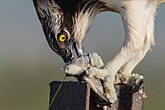



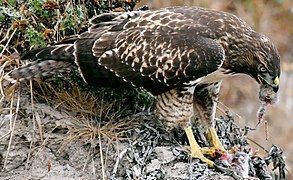
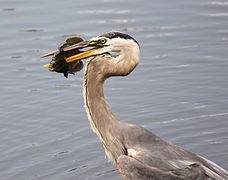
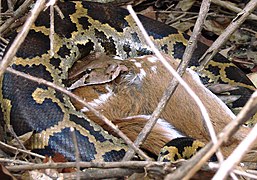
![Auroralumina attenboroughii, an Ediacaran predator (c. 560 mya). It was a stem-group cnidarian, catching prey with its nematocysts.[165]](http://upload.wikimedia.org/wikipedia/commons/thumb/6/63/Auroralumina_attenboroughii_reconstruction.jpg/157px-Auroralumina_attenboroughii_reconstruction.jpg)
